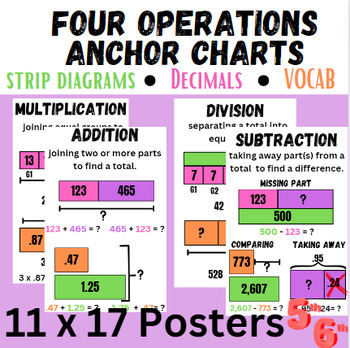Math Four Operations with Decimals and Strip Diagram Anchor Charts 11x17
Teaching Kellen Kids
11 Followers
Grade Levels
4th - 6th
Subjects
Resource Type
Standards
CCSS4.NBT.B.5
CCSS4.NBT.B.6
CCSS4.OA.A.2
CCSS4.OA.A.3
CCSS5.OA.A.2
Formats Included
- PDF
Teaching Kellen Kids
11 Followers
Also included in
- Create a four operations decision tree on your wall to help all your students decide between addition, subtraction, multiplication, and division. Designed to be a focal point and large anchor charts to be used the entire year and deepen your students' understanding of the four operations.Included inPrice $10.35Original Price $11.50Save $1.15
Description
Students can use these vibrant visuals to see multiple representations of addition, subtraction, multiplication and division with whole numbers and decimals. Anchor charts are designed to be printed 11 x 17.
Poster includes strip diagrams, color coded equations, communative properties, and vocabulary.
See "Do I have a Total" anchor chart diagram bundle if you would like the anchor charts, as well as the labels, key vocabulary, and questions for each operation.
Total Pages
Answer Key
N/A
Teaching Duration
N/A
Report this resource to TPT
Reported resources will be reviewed by our team. Report this resource to let us know if this resource violates TPT’s content guidelines.
Standards
to see state-specific standards (only available in the US).
CCSS4.NBT.B.5
Multiply a whole number of up to four digits by a one-digit whole number, and multiply two two-digit numbers, using strategies based on place value and the properties of operations. Illustrate and explain the calculation by using equations, rectangular arrays, and/or area models.
CCSS4.NBT.B.6
Find whole-number quotients and remainders with up to four-digit dividends and one-digit divisors, using strategies based on place value, the properties of operations, and/or the relationship between multiplication and division. Illustrate and explain the calculation by using equations, rectangular arrays, and/or area models.
CCSS4.OA.A.2
Multiply or divide to solve word problems involving multiplicative comparison, e.g., by using drawings and equations with a symbol for the unknown number to represent the problem, distinguishing multiplicative comparison from additive comparison.
CCSS4.OA.A.3
Solve multistep word problems posed with whole numbers and having whole-number answers using the four operations, including problems in which remainders must be interpreted. Represent these problems using equations with a letter standing for the unknown quantity. Assess the reasonableness of answers using mental computation and estimation strategies including rounding.
CCSS5.OA.A.2
Write simple expressions that record calculations with numbers, and interpret numerical expressions without evaluating them. For example, express the calculation “add 8 and 7, then multiply by 2” as 2 × (8 + 7). Recognize that 3 × (18932 + 921) is three times as large as 18932 + 921, without having to calculate the indicated sum or product.



